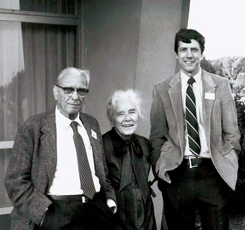  |
| Updated on 28 April 2025 |
|
Home >
Database
» Linguliformea
» Craniiformea
» Rhynchonelliformea
List of species and genera
Number of taxa
References
SIBIC
Photo album
Links About Us Contact Us
|
Brachiopoda, commonly known as lamp-shells, are solitary, sessile benthic marine invertebrates, mainly related to the other lophophorate phyla the Phoronida and the Bryozoa. They are two-shelled with a dorsal (formerly named brachial) valve and a ventral (formerly named pedicle) valve, and filter-feeding with a ciliated, tentaculated feeding organ named the lophophore, usually supported by the brachidium. Most brachiopods are attached to the substrate by means of a pedicle, while others are cemented or lie freely. Some species that have long pedicles do not attach to a hard substrate but anchor the pedicle deep in the sand. The three subphyla types are recorded since the Lower Cambrian (about 600 MY ago) but they probably date back to at least 800-1,000 MY ago. The brachiopods were particularly abundant in the Palaeozoic but have progressively decreased in diversity toward the Recent. From the about 5,000 described genera, and about 30,000 described species, the numbers of extant taxa, some being know as fossils, are frequently updated. Extant representatives are found from the littoral waters (generally subtidal) through to the abyssal zone, and are generally epifaunal on hard substrata; only the lingulides are exclusively infaunal in soft substrata. They range in size from one millimetre to over nine centimetres. Larvae are either planktotrophic or non-planktotrophic.
Citation This database is protected by the copyright related to intellectual property and Web publications according to the EU laws as well as Spanish and French ones. Consequently this website should be cited as follows: • Emig C. C., Bitner M. A. & Álvarez F., 2021. Brachiopoda database. Accessed at http://paleopolis.es/brachiopoda_database on dd-mm-2021.
Our "Brachiopoda database" is hosted by  que es la red académica y de investigación española Short History of the DatabaseDuring the 60’s and 70’s, in the National Museum of Natural History, Smithsonian Institution, Mrs. Josephine Cooper, Arthur’s spouse, of the department of Paleobiology has updated on 3x5 cards bibliographic & generic information on fossil and extant brachiopods. It truly was a monumental job: over 10,000 cards. This treasure of information was awaiting someone to computerize this, so the brachiopodologists could access it. In 1973, when Rex A. Doescher, as a fledging new assistant to Richard Grant, joined the Smithsonian, the computer was in its infancy and there was no mechanism for bibliographic software. In the 80's he did stumble upon Papyrus (a PC software) and which became the perfect program for the bibliographic data, at this time on PC. In France, at early 80’s, Bernard Laurin began developing the first brachiopod database on Macintosh upon 4D software, a useful tool for the RCP-CNRS 728 (1983-1989). Christian C. Emig, head of this program, used the tool for managing together bibliography, cruise data, list and diagnoses of taxa, etc. Gus Arthur and Josephine Cooper and Rex Doescher in Brest > From 1983 to 1986, Rex Doescher edited the "Armfoot" Newletter, one # each year and a special edition in 1985 for the 1st Congress in Brest: download in pdf (9.3 MB) In 1985, the First International Congress on Brachiopoda in Brest (France) was an important event to promote the use of computers and Internet as well as the revision of the part H Brachiopoda of the Treatise of Invertebrate Paleontology. On the other side of the Atlantic Ocean, Rex Doescher, in consultation which Richard Grant, made up the name SIBIC (Smithsonian International Brachiopod Information Center), created in 1990 with the software Gopher. In 1995-1996, the situation changed drastically, G. Artrhur Cooper retired and left the Museum, and Richard Grant had a sudden heart attack and passed away. New political management dropped the funding and many researchers of the Smithsonian had to retire, among them Rex Doescher, under government pressure and financial drop down. In the early 90’s, Rex Doescher, Fernando Álvarez (during his working visits to the Smithsonian in the summers of 1991-94) and Christian C. Emig discussed the project of a brachiopod web site. In 1995, with Rex’s ineluctable retirement and on his request, Christian C. Emig decided to prepare a web site on Brachiopoda to ensure a continuum because the SIBIC will be shut down. In September 1995, the first pages appeared online under BrachNet on the server of the Centre d’Océanologie de Marseille (University-CNRS), formerly Station Marine d’Endoume. In the early 2000’s BrachNet moved to Paleopolis, a web portal of Rediris (Ministry of Education, Madrid, Spain). Within the European programs ERMS and MarBEF, the need to create a scientific database for each main zoological phylum was emphasised among the members. As a complementary mirror-site of BrachNet, I, as author and editor, launched the World Brachiopoda Database in 2005 on the portal WoRMS; in 2011, Fernando Álvarez and Maria Aleksandra Bitner joined to contribute to the editing task. In 2013, the management of WoRMS changed, and several dysfunctions affecting the scientific reliability of the brachiopod database appeared Fernando Álvarez - Maria Aleksandra Bitner - Christian C. Emig Since 2006, the Brachiopoda database is part of Catalogue of Life (ITIS - Species 2000)
|
|
|






